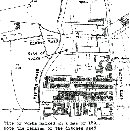Calico Printing Works near Kimber Road Wandsworth
These works were situated on the east bank of the Wandle, on a site near the south side of the present Kimber Road, which runs to Merton Road from a point in Garratt Lane about half a mile north of Earlsfield Station.
The earliest indication found of premises there was on John Rocque's map of London of 1741-45, whereon some buildings are shown though not identified. It seems likely, or at least possible, that the works were occupied for a time by Richard Walker, about whom a little information has been found.
On 11 September 1769, Richard Walker, calico printer, insured his premises in Wandsworth with the Sun insurance company. These included a dwelling house, dyehouse, cutting shop, colour house, print room, printing shop, ware shop, millhouse, calender shop and copper house, and the utensils and goods therein [1]. In June 1770 he was declared to be bankrupt [2]. Subsequently, by order of his assignees, the lease of Walker's works was advertised to be offered for sale at an auction to be held on 6 August 1770 [3].
The first reference found to an occupier who can with certainty be connected with the site was to John Dipple, who was named on the first of the Wandsworth land tax registers, that for 1780, and subsequently up to 1798. John Dipple, "whitener and presser", insured his household goods in his dwelling house, and his utensils and stock in a nearby warehouse, at Wandsworth, with the Sun insurance company, on 20 May 1772 [4]. He took out another policy on those items on 27 September 1787 [5].
John Dipple's association with the works was given by James Edwards in c. 1789, when he referred to "a large old building (situated upon the east bank of the river) belonging to Mr. Dipple. Now Mr. Padmore's callicoe ground." On the map contained in his book, the site is shown with the name "Padmore" printed adjacent [6].
Dipple had evidently sub-let the premises to Padmore for calico printing purposes. George Padmore had previously worked at calico printing works in Wimbledon, on the Wandle a short distance below Merton Bridge, in partnership with Thomas Bowness, from 1785 until they were declared bankrupt in October 1788. Evidently he made a fresh start at Wandsworth soon afterwards.
On 4 January 1790 George Padmore insured his printing house, drug colour house and lifts over, and the utensils and stock therein, and in a nearby calender house, and copper house. Also the household goods in his dwelling house, and in a nearby house occupied by John Dipple [7]. On 19 June 1794 he insured his dwelling house only [8]. George Padmore had probably left the premises by 16 January 1799, when John Dipple was declared bankrupt [9]. Soon afterwards it was announced that, "by order of the assignees", the lease of his premises would be offered for sale at an auction to be held on 3 April 1799. The property was described in the notice thus:
"consisting of a small but convenient new-built brick dwelling house, good garden,
meadow or tenter ground, yard, stable, chaise-house, work-shops, brimstone stoves, and
out-buildings, suitable for a whitener, in which line they have been established above 40 years
... likewise a roomy house, printing and pencilling shops, bleaching ground and premises ...
Also the lease of 182 acres of land in the Common South Field."
[10]
The lease of part of the premises was taken up at this auction, but not the lease of the calico printing works, which was offered for 54 years by private sale a few weeks later, in June 1799 [11].
The outcome is not entirely clear, but evidently at some time the lease was taken up by William Bennett, perhaps soon after 22 June 1799 when his partnership with William Ansell, as calico printers elsewhere in Wandsworth, was dissolved [12]. Bennett was then briefly in partnership with Matthew Simpson, who resigned on 24 June 1800 [13]. William Bennett next went into partnership with William Athill Moore, but Moore left on 10 February 1801 [14], and on the same day he sold his share of the lease and the utensils to Robert Barker [15]. Robert Barker and William Bennett were named as calico printers at Garratt Lane in Holden's directory for 1802-4, but they dissolved their partnership on 30 June 1804 [16]. Bennett left and went to work at calico printing works at Duntshill, and Barker carried on alone. A notice was published during August 1812 advertising the sale by private contract of the freehold of the premises. These comprised
"a very comfortable, convenient, new-built and handsomely fitted up dwelling-house,
replete with every requisite accommodation ... productive gardens, orchard, lawn, fish-ponds,
coach-house, stabling and suitable offices; several inclosures of uncommonly rich
meadow-land, and extensive substantial buildings, and grounds of every description for
carrying on the trades of a calico-printer, bleacher, and dyer ... The whole is in a capital state
of repair ... "
[17]
 |
The mill in 1865 [93.5kb] |
The above notice included the information that "in a short time will be sold all the valuable erections of the printing-shops, copper house, blue house", etc., but it was not until some four months later that an advertisement was published informing that an auction would be held on the premises on 25 February 1813 and following day. Offered for sale would be "all the valuable and useful building materials" of the house and all the factory buildings, "the whole to be taken down and cleared away by the purchasers" [19]. It seems likely that the buildings were then sold and demolished. No later reference to the works has been found.
|
|
|
|